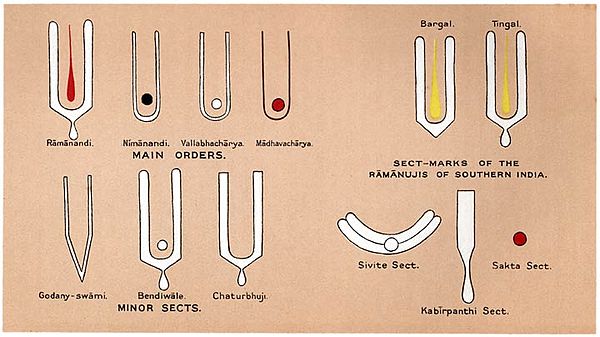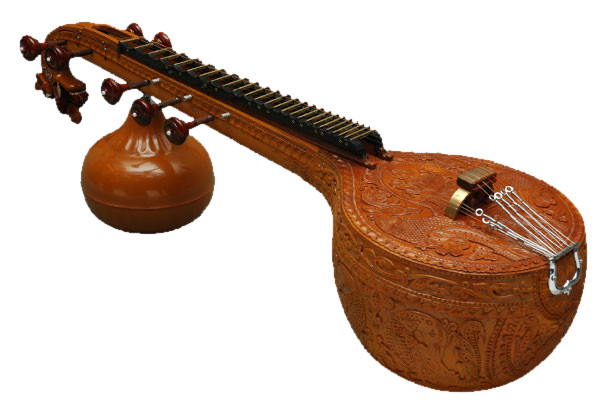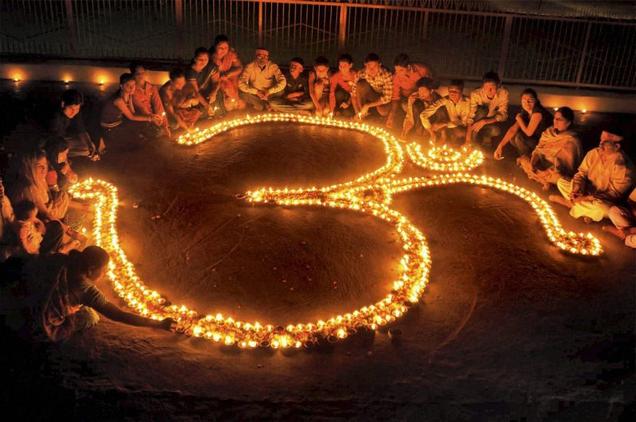No products in the cart.
Hinduism has incorporated various iconic symbols, which are part of Hindu iconography, that are imbued with spiritual meaning based on either the scriptures or cultural traditions, during the millennia of its history. The actual meaning ascribed to each image varies depending on the place, time era, and designation of the followers. Some of the symbols, such as the Swastika, have gained greater recognition through time, while others, such as Aum, are acknowledged as distinct emblems of Hinduism. Murti, which refers to icons, and mudra, which refers to movements and body postures, cover other parts of Hindu iconography.
There are different Hindu rituals also.
Hindu sacraments
Hindu sacraments are tangible things or marks that are considered sacred and utilised by adherents of Sanathana dharma as a show of devotion (Hinduism). These are frequently found as part of a puja (prayer) or religious rite.
Tilaka

The tilaka or tilak is a spiritual devotional mark worn on the forehead or other regions of the body. Hindus may wear a tilaka on a regular basis or for special occasions. The tilaka’s form is frequently a sign of devotion to a particular god. A tilaka in the shape of a ‘U’ signifies devotion to Vishnu, whereas Shiva worshippers wear it in the form of three horizontal lines. Saffron, vermilion, turmeric, clay, or just ash can be used to make it.
Married Hindu women typically wear a colourful vermilion dot or bindu, or bind, on their foreheads to indicate marriage and auspiciousness. In Western nations, this is similar to a wedding ring. The mark is known as pottu in southern India (or bottu). The actual shape, size, and placement of the bindi or pottu varies by area; for example, in northern India, the bindi is worn just below the hairline, but in southern India, it is worn between the eyebrows. Larger bindis are historically worn in east India, particularly in West Bengal, as a sign of devotion to Goddess Durga.
Vibhuti

The holy ash obtained from religious puja procedures involving fire is known as vibhuti (☰). A version known as Basma, which is used as Vibhuti, is made from cleaned ashes of cow dung. As a byproduct of fire, ash is said to be naturally clean. It’s usually drawn as three horizontal lines on the forehead to represent Shiva. Some Hindus combine Shiva’s three horizontal vibhuti lines with Vishnu’s ‘U’ shape thilaka to form a Hari-Hara amalgam marking (Vishnu-Shiva). Furthermore, holy ash denotes that the body’s genesis is dust and ash, and that it will return to dust and ash. The ash is a symbol of transience. Everything in the meantime is really a figment of the imagination (maya).
Rudraksha

Rudraksha (📿) are the seeds of the rudraksha tree, which in Hinduism symbolise Lord Shiva’s tears (also known as, Rudra). They’re frequently strung on a necklace and used as a rosary to aid prayer and meditation.
Universal Symbols
Om
/om-pendent-on-wood-texture-background-and-greeting-811535700-5ad3d9eaeb97de003701366d.jpg)
Om (or Aum, ॐ) is the sacred sound sign for the Universe, which represents the ultimate reality (Brahman). All Vedic mantras and prayers have it prefixed and occasionally suffixed. The three aspects of God, Brahman (A), Vishnu (U), and Shiva (S) are sometimes believed to be represented by Aum (M). It signifies the one ultimate reality, underlying and encompassing everything of nature and all of life, as the Divine primal vibration. Omkara, ॐ, the written syllable for Hindu dharma, is a profoundly meaningful and easily identifiable symbol. The pronunciation of Aum differs from that of Om in that it passes through all conceivable human language vowel sounds. Both are frequently used interchangeably in terms of symbolism, despite the fact that they are musically unique.
Swastika

Swastika is a sign that denotes good fortune in general. It might signify the sun, Surya, or purity of the spirit, truth, and stability. Its four-direction rotation has been used to represent a variety of concepts, but it is most commonly used to signify the four directions, the four Vedas, and their harmonious totality. It has been used in Hinduism from ancient times.
Sri Chakra Yantra

Tripura Sundari’s Sri Chakra Yantra (also known as Sri Yantra) is a mandala made up of nine interconnecting triangles. Four of the triangles are erect, symbolizing Shiva or the Masculine. Inverted triangles signify Shakti, or the Feminine, in five of these triangles. The nine triangles create a web, which represents the entire cosmos, and a womb, which represents creation, and together they reflect Advaita Vedanta, or non-duality. This greatest yantra is the source of all other yantras.
Symbols associated with individual deities
Several symbols (animals, plants, instruments, weaponry, or even colour) are connected with specific devas in Hindu iconography, and vice versa. In certain situations, deities are personifications of natural forces, such as Agni (fire), Vayu (wind), Surya (Sun), and Prithvi (water) (Earth). In other cases, the correlations are based on specific experiences or qualities that are associated to Hinduism. In its visual or sculptural depictions, the iconography serves to identify the specific god. The deities are frequently associated with a natural or human trait or vocation through symbolism.
To grasp the allegorical references in not just Hindu texts (for example, Puranic stories), but also ancient and current secular works by authors from the Indian subcontinent, it is necessary to understand symbolism. The study of sculpture and religious adornment as described in sacred scriptures is part of the art and science of temple design (shilpa shaastra aagamas). An excellent and experienced instructor used to provide the pupil twelve years of academic and practical training in Ancient India.
Shiva Lingam

The Shiva Lingam is a Hindu deity that represents the holy being Shiva and is a sign of fertility and strength[citation needed]. In Hinduism, the Shivalinga (Sivalinga) is the most prominent and well-known symbolic image of Lord Shiva (Siva). It depicts God in all three of His facets: Creator, Sustainer or Protector, and Destroyer (Dissolutor).
Lotus

The gods Vishnu, Brahma, and Lakshmi are all linked with the Lotus in Hindu mythology. It is a sign of fertility and beauty. “A human should labour without attachment, offering their acts to God, unaffected by sin like water on a lotus leaf, like a magnificent flower towering high above the muck and water,” according to the Bhagavad Gita.
Veena

The Hindu goddess Saraswati and the sage Narada are both linked to the musical instrument Veena. It is a symbol of study and the arts.
Conch

The conch shell is a key Hindu prayer object that is used to make various trumpeting announcements. Vishnu, the God of Preservation, is reported to be holding a particular conch called Panchajanya, which depicts life as it emerges from life-giving waters. The holy conch plays an important role in Dhruva’s narrative. Warriors in ancient India would blow conch shells to signal battles, as seen in the Mahabharata’s renowned battle of Kurukshetra. The conch shell is also deeply rooted in Hindu religious and symbolic heritage. Most Hindus today employ the conch as part of their religious rituals, blowing it at certain times during worship and accompanied by ceremonial bells. Shankha also represents wisdom and the sound that created the cosmos.
Chakra
Vishnu’s Chakra, or disc-like weapon, is frequently seen atop Vaishnava temples or incorporated into architectural designs. The Chakra is usually often shown in one of Vishnu’s four-armed Narayana form’s hands. It’s a protective sign in general. Chakra is also said to represent the importance of adharma and the necessity to follow dharma.
Multiple heads and arms
Multiple heads, arms, and other body parts are frequently shown in Hindu, Buddhist, and certain Jain deities, resulting in what one author refers to as a “multiplicity convention” in religious iconography. The divine omnipresence and immanence (capacity to be in many locations at once and concurrently exist in all places at once), and hence the power to affect many things at once, are symbolised by such numerous bodily parts. In the context of an image, the precise meanings assigned to the various bodily parts are symbolic, not literal. The visual impact of an array of many arms in such renderings is to produce kinetic energy, demonstrating that ability.
Vahana
In Hindu mythology, a vahana or vehicle, often known as a mount, is an animal or legendary being strongly linked with a specific god. The god is sometimes iconographically shown riding and/or mounted on the vahana; other times, the vahana is symbolically represented as a divine attribute or is pictured by the deity’s side.
Symbols associated with Hindu Gods, Deities and Mythological Figures
- Adi Parashakti – Chariot of seven lions, Sri Chakra
- Brahma – Lotus, swan (hamsa), Vedas, garland of beads (akshamala)
- Vishnu – Shesha, shankha, chakra, gada, lotus, Garuda, color blue
- Shiva – Shiva Linga, Nandi, third eye, trishula (trident), crescent moon, rudraksha, cobra, drum, tiger skin, vibhuti
- Saraswati – White lotus, swan, peacock, veena, color white
- Lakshmi – Red lotus, elephant, shower of gold, kumbha, owl, peacock feather
- Parvati – Lion, Nandi, trident, chakra, gada, padam, couch, cross bow, khadag
- Indra – Thunderbolt (vajra), rainbow, clouds
- Varuna – Noose (pasha)
- Yama – Noose (pasha), danda (rod), buffalo
- Surya – Chariot, sun-rays, the colour of gold
- Kali – Garland of severed human heads, scimitar, khanda, khapar, khadag, trident
- Rama – Bow and arrow, the colour blue, royal panoply
- Krishna – The colour blue, cow, flute, Sudarshana Chakra, milk, peacock feather
- Ganesha – Aṅkuśa, mouse, modak, Aum
- Murugan – Peacock, vel, rooster flag
- Hanuman – Gada
The sign represents good fortune and luck. The om and the swastika are the two fundamental symbols connected with Hinduism. In Sanskrit, the term swastika means “good fortune” or “being joyful,” and the symbol denotes good fortune.






